In the early 2000s, the tech landscape witnessed a shift as companies began recognizing the value of offering APIs to partners and third parties. This presented a new challenge: how to effectively organize and share these APIs, along with their documentation. Alongside this challenge arose a deeper understanding of the importance of the API developer experience.
Understanding API developer experience
API developer experience refers to how easy and enjoyable it is for developers to use and integrate with an API. It includes aspects like clear documentation, intuitive design, reliable performance, and helpful support that make the process smooth and efficient.
If you’ve worked with APIs, you’re likely familiar with API portals designed to provide API definitions, documentation, and method descriptions. These portals were essential for navigating the early days of API adoption.
As we moved into the era of Web 2.0, APIs became increasingly crucial for connecting websites and applications to external resources, catalyzing the growth of the “API economy.” A new API maturity survey finds APIs are now part of the go-to-market strategy for 99.5% of organizations.
This period saw a surge in API adoption driven by cloud services, mobile apps, and SaaS platforms. API portals evolved into sophisticated hubs, offering features like comprehensive documentation, onboarding, testing, and key management.
Today’s IT landscapes, characterized by multi-vendor environments and complex digital ecosystems, demand more than these foundational features. Enterprises today recognize that the value of their APIs is not in their existence alone, but in their consumption – or in other words, that higher API ROI hinges on higher API consumption.
Enter Axway’s Amplify Engage. Launched in 2022 under the Amplify product line, it represents a significant leap forward in API management. Designed to address the needs of modern developers, Amplify Engage provides a complete marketplace experience built on federated API management, enabling you to discover, organize, govern, secure, and consume APIs as polished product offerings.
Let’s delve into six critical elements of a good API developer experience – and why an API marketplace drives stronger API adoption by making it easier and more enjoyable to use your APIs.
Developers in the role of API provider & API consumer
First, it is of key importance to define what kind of roles developers can have when we are talking about APIs. More and more often in large organizations, development teams are responsible for creating applications with all integration capabilities included in the application (APIs in the broadest sense of the word).
Two key roles can be distinguished when talking about developers and APIs:
- API provider: as part of the application or (micro)service being developed by a developer, one or more APIs are created. First, every API needs to meet the minimum (security) requirements set by the organization. Secondly, the API needs to be made available to others to drive reuse of the API as much as possible.
- API consumer: to avoid duplicating development of the same service more than once, it is key that every single developer can easily find all APIs in a centralized catalog or repository. Every single developer should, before creating a new API, look if the information he/she needs can be delivered by one or a combination of APIs already.
Let’s start looking at important capabilities in a marketplace for developers in the role of API provider, then at what developers in the role of API consumers need.
See also: 5 things producers and consumers need from an API marketplace
Note: needless to say, a successful API strategy involves many more roles than just developers, such as architects, security experts, API Product Owners, (IT) management, business owners, etc. In this article, we’re looking mainly at the role of developers, but you can explore the role of an API product manager here, or dive into other roles involved in API programs here.
1. Automate API discovery, validation, and monitoring
In the above-mentioned survey, 78% of enterprise decision-makers said they don’t know how many APIs they have. Lack of an accurate inventory is a concerning security risk – and as noted previously, it can also lead to waste: it’s very difficult for developers to reuse before building a new API if they can’t easily see what’s available.
Enterprises are struggling to get the visibility and control they need, and it’s impacting the API developer experience. Developers in the role of API provider need tools that leverage the APIs of your target systems to perform key functions such as discovery, validation, and monitoring.
Amplify Agents support developers by automating many of the tedious and time-consuming tasks associated with API management.
Amplify Agents are lightweight software applications available in two types: the Discovery Agent and the Traceability Agent. These agents act as connectors between your existing API environments and Axway’s Amplify management plane.
- With the Discovery Agent, developers can automatically identify and catalog all APIs within their ecosystem, simplifying the process of keeping track of numerous APIs.
- The Traceability Agent provides detailed insights into API usage and performance, helping developers quickly identify and resolve issues.
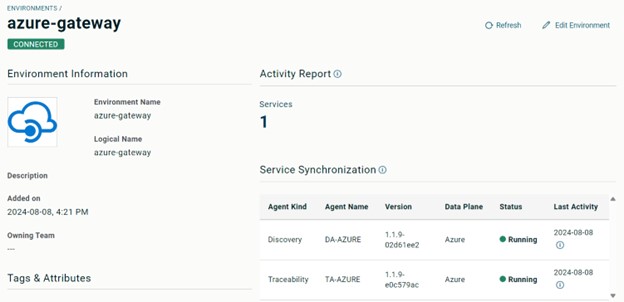
Overview of a registered gateway within Amplify Marketplace, featuring an active Discovery and Traceability agent
2. Ensure developers have access to every asset in one place
The lack of adequate visibility over assets is worsening with API proliferation. And one of the most challenging aspects of API management is discovering and cataloging APIs across multiple environments.
Most companies today don’t have just one API platform, but several, and they leverage multiple API models, including REST, events, and integration flows, spread across multiple clouds from multiple providers.
See also: There is no best API style. But there is one best solution for all of them.
Only 1/3 of APIs are being managed by a centralized operations team, according to the state of enterprise API maturity survey. The rest are left to individual internal teams or managed by external parties.
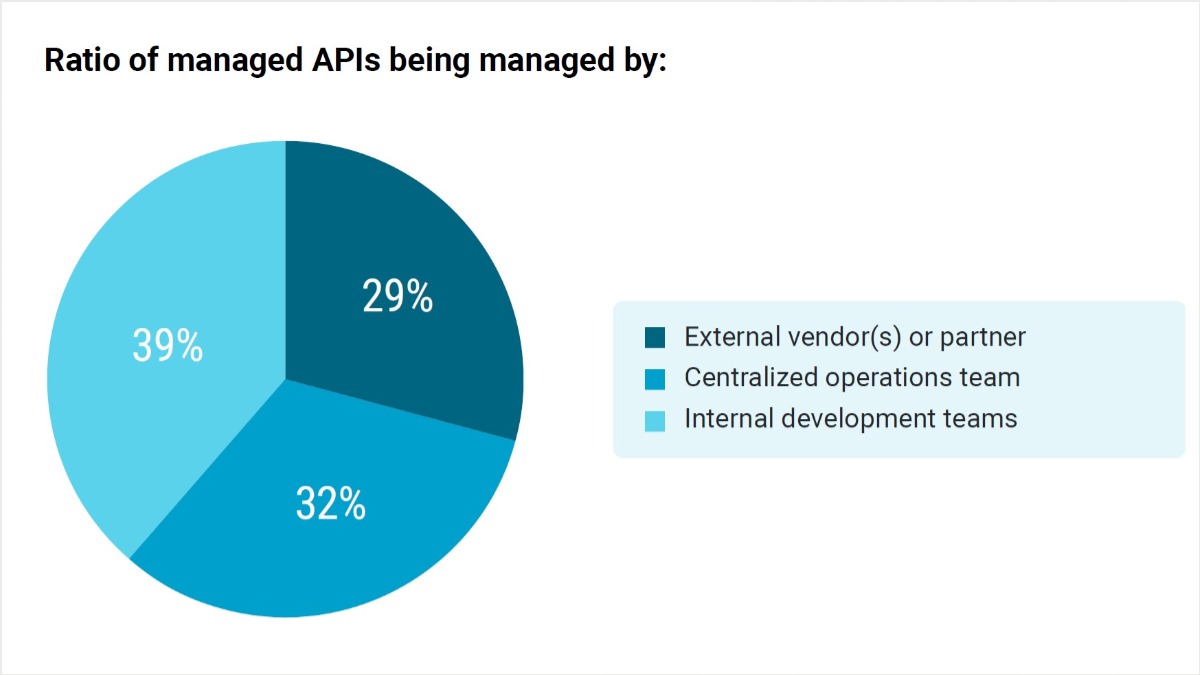
Registered APIs are cataloged or otherwise maintained by a mix of automated and manual methods.

95% of respondents agree that a centralized API catalog would improve the governance of APIs.
For API providers, consolidating all APIs into a single, searchable directory would enhance discoverability by making it easier to find and manage them effectively.
That’s why Axway offers agents for a range of gateways, including AWS, Azure, Apigee, Mulesoft, and Kong. These agents can identify various specifications on these gateways, such as Swagger, OpenAPI, AsyncAPI, WSDL, and Protobuf, as well as services like SOAP, REST, GraphQL, and gRPC.
The Service Registry in Amplify Marketplace connects with an agent and functions as a centralized directory that stores detailed information about all available APIs and services within your organization.
Recently, we’ve expanded our portfolio to include new agents for Apigee X, GitLab, Kong API Gateway, GitHub, and Kafka. These additions enhance our capability to support a broader range of platforms, allowing you to consolidate APIs from various sources into a unified view.
With Amplify Marketplace, you benefit from a single-pane view, making it easier to manage and utilize your APIs. Whether you’re integrating APIs from GitHub, managing Apigee X APIs, or working with Kafka streams, Amplify Marketplace provides the tools you need to streamline your API strategy.

The service registry displaying various discovered APIs from different gateways
3. Elevate API security and validation for developers providing APIs
Beyond making for a disjointed API developer experience, insufficient visibility over the API stack can expose an organization to monitoring and governance issues.
When organizations have a spread-out API ecosystem without a clear way to enforce API security standards and practices, the burden of API security falls squarely onto developers’ shoulders.
This is reflected in our recent API maturity survey, where decision-makers felt the greatest security risk to their organizations from API use is security being left to dev teams, followed by lack of accurate API inventory and unmanaged APIs.
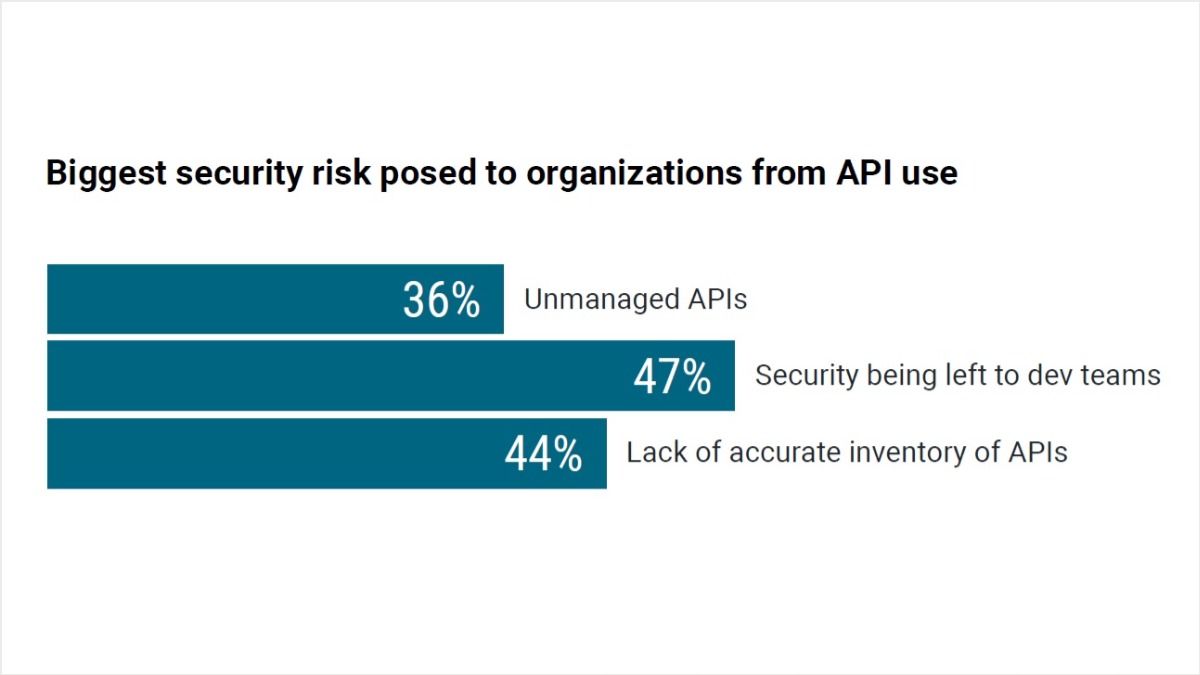
Other vulnerabilities enterprises face include:
- different security configurations for internal vs. external APIs (46%),
- unrestricted resource consumption (i.e. DoS attacks — 43%),
- inadequate access and authorization controls (41%),
- and lack of common security policy enforcement for APIs (37%).
See also: From Zombies to Legacy or Shadow APIs, it’s time to remediate your lost APIs
API developers shouldn’t have to carry the burden of securing your enterprise’s most sensitive data alone. Integrating API linting directly into your workflow helps uphold the highest design and security standards in a more automated, streamlined way.
Security and compliance are critical aspects of API management, and the Amplify Platform is designed to support developers in these areas. Once your APIs and services are discovered by the agents and registered in the service registry, Amplify Marketplace provides built-in security checks to ensure their integrity.
The embedded Spectral linting server automatically evaluates your APIs against predefined rules, identifying potential issues early in the development cycle. Developers can customize these rulesets to align with their organization’s specific needs, enabling a tailored approach that addresses unique requirements.
A more seamless validation process instills confidence before exposing APIs for monetization or public use, ensuring they are designed correctly and adhere to all necessary security protocols and guidelines.
With Spectral integrated into the Amplify Platform, you can build APIs with the assurance that they are robust, secure, and production ready.
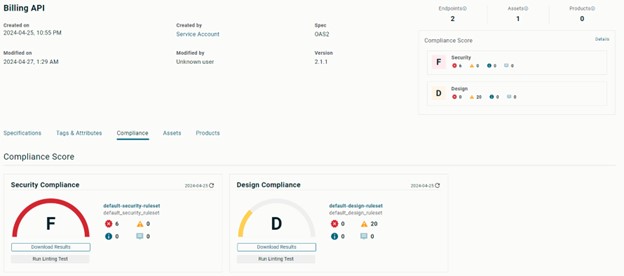
An API with a low score on security and design as assessed by Spectral
4. Equip API providers to deliver value to API consumers with API productization
Treating APIs as products — not just technical interfaces— is key to success. Some 80% of organizations offer digital products today, per the previously mentioned enterprise API maturity survey.
But what, precisely, constitutes an API product? Survey respondents consider that performance metrics and business/technical documentation enable an API product to be effective.
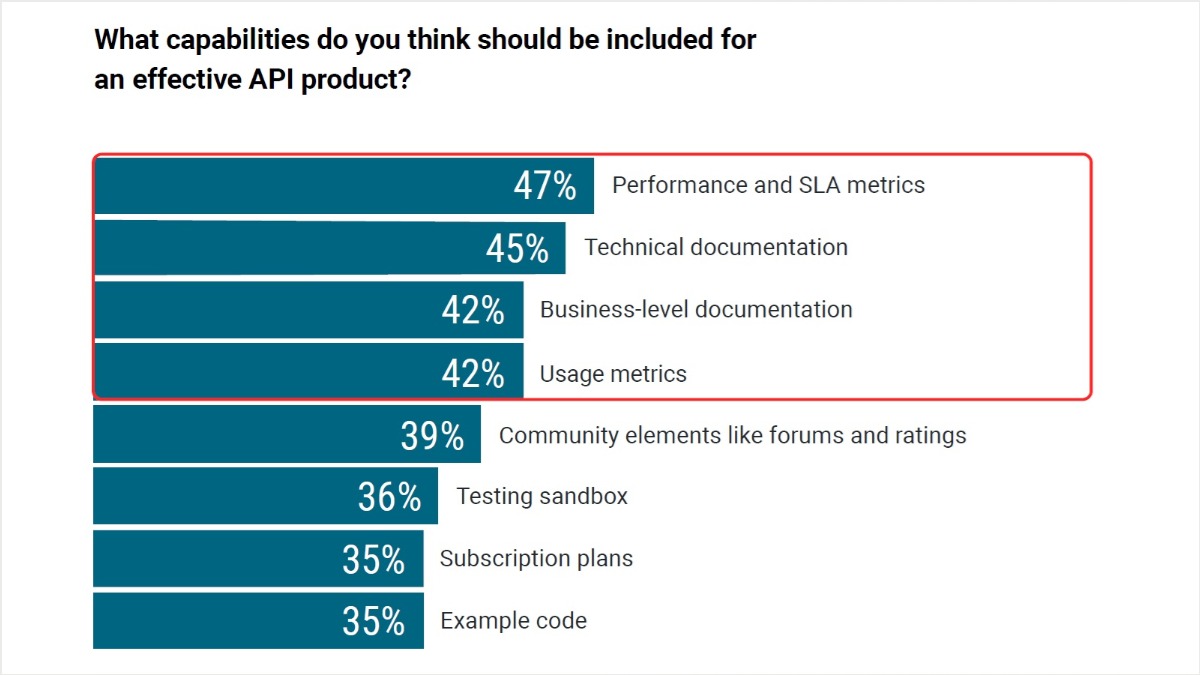
API producers need to know the quality of their APIs (performance and SLA metrics) and how they are being employed (usage metrics), and API consumers need to know how (technical documentation) — and why (business-level documentation) — to use them.
Other capabilities like community forums and ratings, testing sandbox, easy-to-use subscription plans, or example code also contribute to building a more complete API product.
Turning APIs into market-ready products is essential for maximizing their value, which is why Amplify Marketplace offers targeted features to streamline this process.
Integrate existing documentation from various formats, so you can reuse documentation across multiple API products, saving time and ensuring consistency. The platform also enables you to organize your APIs into hierarchical categories, simplifying their management and discovery, even within large inventories.
Developers in the role of API provider can collaborate with business-oriented roles to transform APIs into actual products for re-use or monetization. Amplify Marketplace facilitates this collaboration by offering tools to package and present APIs as polished, ready-to-use products.
Business-oriented roles can leverage these features to refine API offerings, define pricing strategies, and create comprehensive product listings that appeal to API Consumers.
By leveraging Amplify Marketplace, you can efficiently convert your APIs into valuable assets that are accessible and attractive to users. This approach not only fosters broader adoption but also enhances your development workflow by providing a unified and effective platform for API management and productization.
5. Boost adoption with an enhanced API developer experience
API marketplaces should enable both internal and external API consumers to benefit from advanced search capabilities, allowing them to easily navigate through detailed API definitions, specifications, and documentation to find exactly what they need.
Successful API adoption relies on seamless developer experience.
Some organizations find it valuable to create one or more marketplaces tailored for API consumers, whether they are internal or external. This flexibility allows you to set up an internal marketplace for internal use, streamlining API access across departments, or an external marketplace where monetization may be a key focus.
See also API monetization models: Strategies to leverage APIs for greater revenue
Amplify Marketplace is designed to streamline your API integration process, enhancing your overall experience and driving successful adoption.
The “Try It Now” feature provides an embedded testing environment that supports OAuth2.0, enabling quick and secure trials of APIs. User feedback is gathered through ratings and reviews, which helps in continuously improving API offerings.
To simplify the sign-up process, we offer social login options with Google, GitHub, or GitLab credentials. Billing integration with systems like Stripe ensures a smooth monetization experience, making payment and revenue collection effortless.

An example of a customized marketplace.
6. Offer developers valuable insights – for both API consumers and providers
Visibility into API usage and performance is essential for making informed decisions.
Both business and technical performance metrics are important to accurately measure ROI. And ensuring alignment on how an API’s success will be determined is crucial to ensuring APIs are being developed correctly to meet an organization’s goals.
Amplify Marketplace provides a robust Business Insights dashboard that delivers actionable data. For API consumers, the dashboard offers secure, self-service access to usage metrics, enabling users to optimize their interactions with APIs.
For API providers, engagement metrics offer valuable insights into the health of your API program, while the subscriptions dashboard tracks how different consumer teams use their API subscriptions, ensuring effective governance. These insights empower you to refine your API strategy, enhancing both security and adoption.
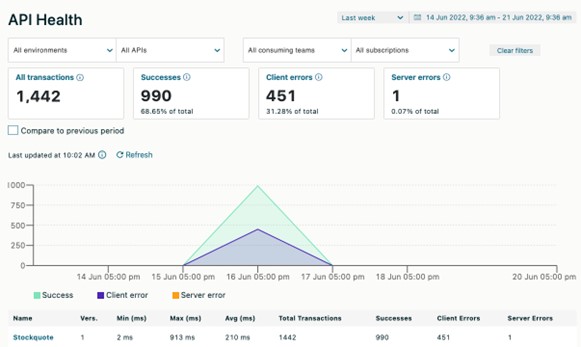
A dashboard view from the API provider’s perspective.
7. Bonus: understanding how an API marketplace best serves the developer experience
In the following video, William McKinney, Senior Director of Amplify Platform Marketing, discussed the value of an API marketplace for developers and how it helps enhance their experience to drive greater API adoption.
Revolutionize your API developer experience with Axway’s Amplify Engage
All the APIs in the world cannot make a difference if they remain unused. It’s one reason that a more seamless developer experience has such an impact on the success of an enterprise’s API program.
Amplify Engage speeds the delivery of digital initiatives and drives API value by allowing developers to easily find and use proven API products that are validated, fully documented, and production ready.
By enhancing your API developer experience, you will lower the barrier to entry to producing and consuming your digital business initiatives.
This API marketplace is the only API developer portal you need. Learn why.


